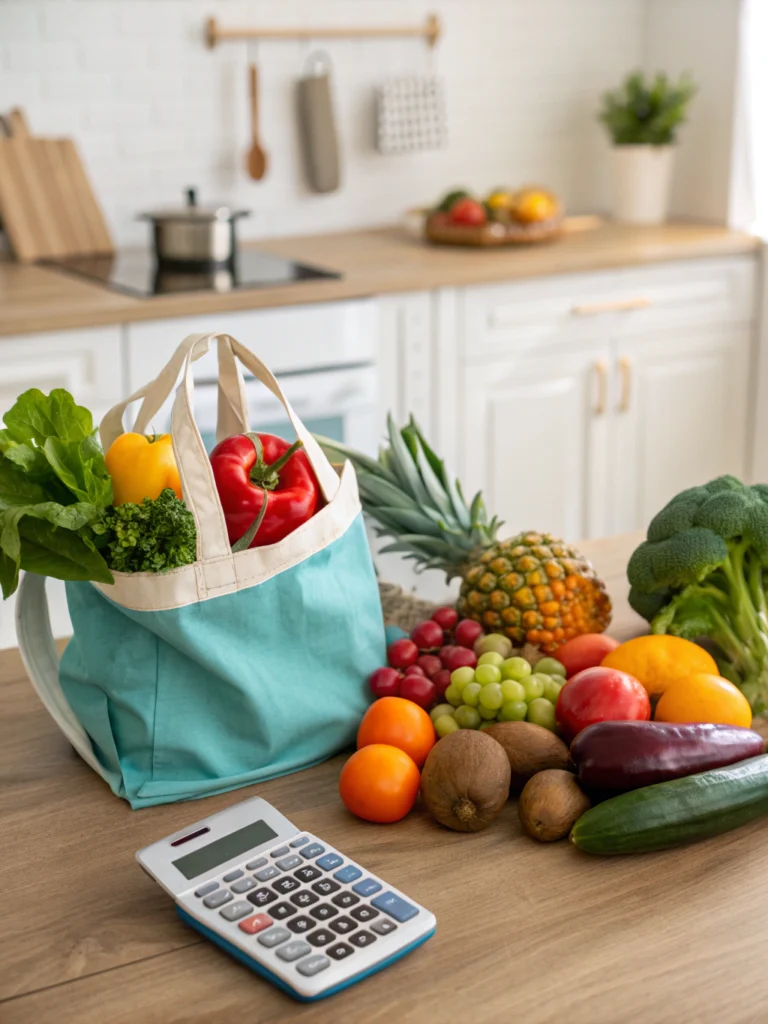Ever feel like you walked into the grocery store for “just a few things” and somehow left with a receipt longer than your arm and a bank account that’s crying? Yeah, me too. It’s wild how those innocent trips can turn into budget-busting disasters faster than you can say “organic avocados.” But here’s the good news: learning how to save money at the grocery store doesn’t require a finance degree or living off ramen for the rest of your life.
The truth is, grocery shopping is one of those sneaky expenses that quietly drains your wallet if you’re not paying attention. But with a few smart strategies—like meal planning, strategic coupon use, and tweaking your shopping habits—you can seriously slash your grocery bill without sacrificing the good stuff. In this post, I’m breaking down the real, actionable tips that actually work for everyday shoppers who want to keep more cash in their pockets.
Table of Contents
No time to read the whole post? Here’s the quick scoop: You can dramatically cut your grocery spending by planning meals before you shop, using coupons and apps strategically, buying generic brands, shopping seasonal produce, avoiding impulse buys, stocking up during sales, and shopping with a full stomach. Combine these tactics and you’ll be saving serious money without eating like a college student. Now let’s dig into the details!
Why Your Grocery Bill Is Probably Higher Than It Needs to Be
Let’s be real—grocery stores are designed to make you spend more. Those end-cap displays? Strategic placement. The milk all the way in the back? Totally intentional. The candy at the checkout? Pure evil genius.
Most people don’t realize they’re falling for these retail tricks, and that’s exactly why their bills keep climbing. Add in some lazy shopping habits (guilty as charged, sometimes), lack of planning, and those “just one treat” moments that happen every single time, and boom—you’ve got yourself a problem.
But once you understand the game, you can play it better. And that’s what we’re about to do.
How To Save Money At The Grocery Store in 8 Steps
Master Meal Planning (Seriously, It’s a Game-Changer)
I used to wing my grocery trips and wonder why I’d end up with random ingredients that never quite made a full meal. Turns out, meal planning isn’t just something Instagram food bloggers do—it actually saves you money.
Here’s why it works: When you plan your meals for the week, you buy exactly what you need. No random purchases. No forgotten vegetables rotting in the back of your fridge. No panic ordering takeout because “there’s nothing to eat” (even though your pantry is full).
Start simple. Pick 5-7 dinners for the week. Write down every ingredient you’ll need. Check what you already have at home (this step is crucial—don’t buy duplicate stuff!). Then make your shopping list based on that plan.
Pro tip: Plan meals that share ingredients. If you’re buying cilantro for tacos on Monday, use it again for a stir-fry on Wednesday. Suddenly, that $2 bunch of herbs doesn’t seem wasteful anymore.
And honestly? Meal planning saves time too. You’re in and out of the store faster because you’re not wandering aimlessly down every aisle hoping inspiration strikes.
Get Smart About Coupons and Apps
Okay, I’m not talking about becoming one of those extreme couponers with a garage full of 300 bottles of mustard. But ignoring coupons completely? That’s leaving free money on the table.
The modern approach to save money at the grocery store involves apps that do the heavy lifting for you. Apps like Ibotta, Fetch Rewards, and Checkout 51 give you cashback on stuff you’re already buying. You literally just scan your receipt and collect money. It’s not revolutionary, but it adds up.
Store loyalty programs are also clutch. Most grocery chains have apps that offer digital coupons, personalized deals, and points toward discounts. Sign up for your regular store’s program and actually use it. I’ve saved anywhere from $5 to $20 per trip just by clicking a few digital coupons before I shop.
And here’s a little secret: stack those savings. Use a digital coupon from the store app, combine it with a manufacturer’s coupon (if allowed), and then get cashback from a rebate app. Triple threat 🙂
Embrace Generic and Store Brands
I get it—some people are brand loyal. But let me tell you, store brands are usually made in the same factories as the name brands, just with different packaging. The ingredients? Often identical or extremely similar.
I started buying generic staples like flour, sugar, canned goods, pasta, and frozen vegetables years ago. The quality difference? Basically nonexistent. The price difference? Significant. We’re talking 20-40% cheaper in many cases.
Sure, there are a few things where I prefer name brands (looking at you, certain cereals and condiments), but for most everyday items, the generic version works perfectly fine. Your tastebuds probably won’t notice, but your wallet definitely will.
Shop Seasonal Produce
Strawberries in December might sound tempting, but they’re gonna cost you. Buying fruits and vegetables when they’re in season means they’re abundant, fresh, and cheaper.
In summer, load up on berries, tomatoes, zucchini, and corn. In fall, go for apples, squash, and root vegetables. Winter? Citrus fruits and hearty greens. Spring brings asparagus, peas, and fresh herbs.
Not only does seasonal shopping save money, but the produce actually tastes better because it hasn’t been shipped from halfway around the world. Win-win.
If you find a great deal on seasonal produce, buy extra and freeze it. Berries, peppers, and even some greens freeze beautifully and give you that seasonal goodness year-round at the sale price you scored.
Beat the Impulse Buy Trap
This one’s tough, not gonna lie. Grocery stores are masters at getting you to buy stuff you didn’t plan for. That’s why the candy’s at checkout, the fancy cheese is at eye level, and the bakery smells amazing the second you walk in.
My strategy? Stick to your list like your budget depends on it (because it does). I also avoid shopping when I’m hungry—huge mistake that leads to buying half the snack aisle.
Give yourself a small “fun money” allowance if you need it. Maybe $5-10 for one impulse item. That way, you’re not feeling completely restricted, but you’re also not going rogue with a cart full of cookies and fancy crackers you don’t need.
Another trick: use the cart strategically. If you’re only getting a few items, grab a basket instead of a cart. Carts psychologically encourage you to fill them up. Baskets keep you honest about what you actually need.
Stock Up During Sales (But Be Smart About It)
When chicken breasts are buy-one-get-one-free or pasta is on sale for $1 a box, that’s your cue to stock up. Buying non-perishables in bulk during sales can seriously cut your costs over time.
But here’s the catch—only stock up on things you actually use regularly. I’ve made the mistake of buying sale items that seemed like good deals but ended up expiring before I used them. That’s not saving money; that’s wasting it.
Focus on:
- Canned goods (beans, tomatoes, broth)
- Pasta and rice
- Frozen proteins (when on deep discount)
- Paper products and household staples
Keep a running inventory at home so you know what you have and what you actually need to restock. A simple list on your phone works fine—nothing fancy required.
Shop At The Right Time
Shopping at the right time can actually save you money. Many stores mark down meat, bakery items, and produce near their sell-by dates. If you shop in the evening or early morning, you might catch these discounts.
I’ve scored packages of chicken marked down 50% just because they needed to sell by the next day. Guess what? I cooked it that night or froze it immediately. Perfectly safe, massively cheaper.
Also, avoid weekend shopping if possible. Stores are packed, shelves might be picked over, and you’re more likely to make rushed decisions. Weekday mornings or evenings tend to be calmer and more conducive to thoughtful, budget-friendly shopping.
Compare Unit Prices, Not Just Package Prices
This is grocery shopping 101, but so many people skip it. The unit price (cost per ounce, pound, or item) tells you the real deal. Sometimes the bigger package is cheaper per unit, but not always.
Stores are required to display unit prices on shelf tags in most places. Take two seconds to compare. That “family size” might actually cost more per ounce than buying two regular sizes, especially if the regular size is on sale.
This habit alone has saved me from countless “bulk traps” where the larger package seemed like a better deal but really wasn’t.
Wrapping It Up
Look, learning how to save money at the grocery store doesn’t mean you need to become some extreme penny-pincher who only eats beans and rice. It’s about being strategic, cutting out waste, and making your money work harder for you.
Plan those meals. Use the apps and coupons that are literally giving you free money. Buy generic when it makes sense. Shop seasonally. Avoid those sneaky impulse buys. Stock up smart during sales. And for the love of all that’s budgetary, don’t shop hungry.
You don’t need to do all of this perfectly. Even implementing a few of these strategies will make a noticeable difference in your grocery spending. Start with what feels doable and build from there.
So yeah, if you’ve been watching your grocery bills creep higher and higher, now’s the time to take control. Try a few of these shopping habits on your next shopping trip and watch the savings stack up. Your future self (and your bank account) will thank you. 😉






